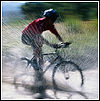 If the chain is too dirty...
If the chain is too dirty...
 he chain can
sometimes get too dirty to clean "on bike".When the chain is too
dirty for on-bike cleaning, it must be degreased. Depending on your riding schedule and
environment, this can be a weekly or monthly job. You need a rivet tool, a solvent such as
kerosene or diesel (HKK recommends transmission fluid), rubber gloves, a paint tray, a
toothbrush, some rags, newspaper to protect the floor, and a well-ventilated work area.
(If you're using a Park or Vetta tool, degreasing is done with the chain on the bike.
Follow the tool's directions.) he chain can
sometimes get too dirty to clean "on bike".When the chain is too
dirty for on-bike cleaning, it must be degreased. Depending on your riding schedule and
environment, this can be a weekly or monthly job. You need a rivet tool, a solvent such as
kerosene or diesel (HKK recommends transmission fluid), rubber gloves, a paint tray, a
toothbrush, some rags, newspaper to protect the floor, and a well-ventilated work area.
(If you're using a Park or Vetta tool, degreasing is done with the chain on the bike.
Follow the tool's directions.)
- Using the chain tool, push any rivet until 80
percent of it protrudes through the side plate. Remove the tool and snap apart the chain
by bending it away from the exposed pin. Shimano Uniglide chains require a special tool to
prevent damage to the bulged side plates. Otherwise, use a standard tool and put the tip
of a small screwdriver behind the bulged plate.
- Measure the chain to see if it needs to be replaced
rather than cleaned. Stretch it straight on a flat surface, and hold the end of a ruler to
the center of any rivet. Then look at the 12-inch mark. On a new chain it will be at the
center of a rivet. If this rivet is at 12 inches or more, the chain is worn and should be
discarded.
- If the chain is usable, coil it flat in the pan.
Cover with solvent and let it soak for 15 minutes. Occupy yourself by picking crud from
between freewheel cogs with a small screwdriver. Put on rubber gloves, moisten the corner
of a rag with solvent, and degrease everything the clean chain will touch (jockey wheels,
freewheel teeth, chainring teeth, front derailleur cage).
- With gloves still on, slosh the chain in the pan to
allow solvent to flow through the links and loosen crud. Wear safety goggles in case it
splashes.
- With the chain submerged, scrub each link with the
toothbrush. Then turn the chain and scrub the other side.
- Pick up the chain by one end. Undo the kinks, use a
clean rag to wipe it from top to bottom, then hang it to dry. Place a rag underneath to
catch drips. Strain the solvent into an unbreakable container labeled "chain
solvent," cap tightly, and store for future use or dispose of it in an ecological
manner.
- When the chain is "dry" (some solvents
leave an oily film), reinstall it. Thread the chain through the front derailleur cage,
over the smallest freewheel cog, and around the pulleys. Leave it off the chainring so you
can easily snap the ends together. Then use the chain tool to push the rivet through,
leaving equal amounts on either side of the link.
NOTE: if you have a unidirectional chain (identified by
asymmetrical side plates), orient it as it was before.
- Bend the link to be certain it moves freely. If it
binds, grasp the chain on either side and flex it laterally until it loosens.
- Lubricate and wipe the chain as described under
"Chain Care."
|
|
|
